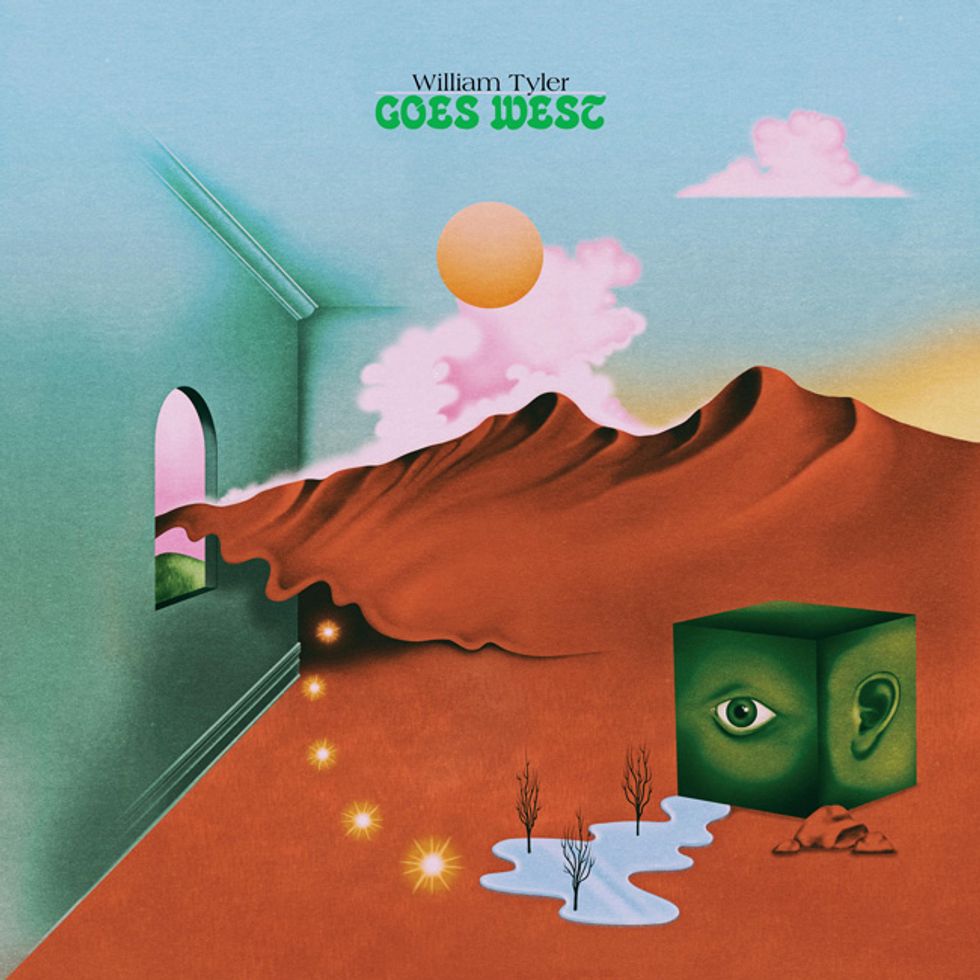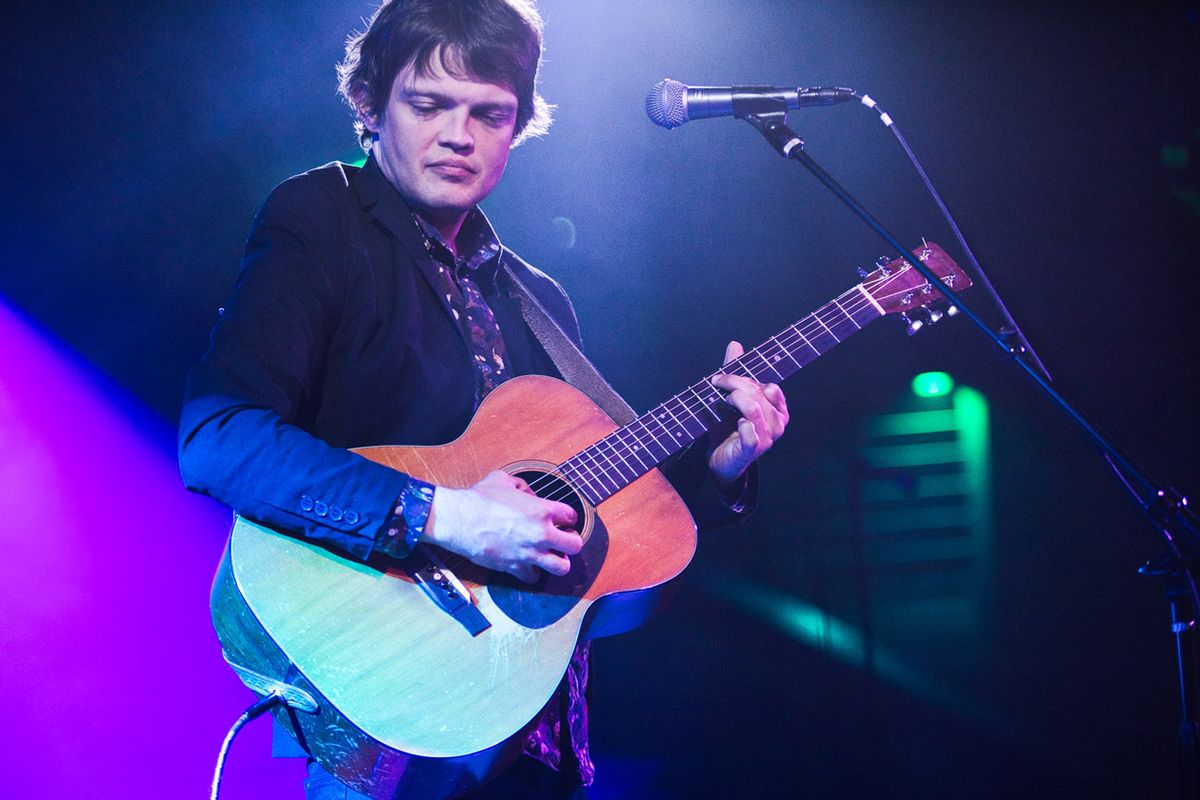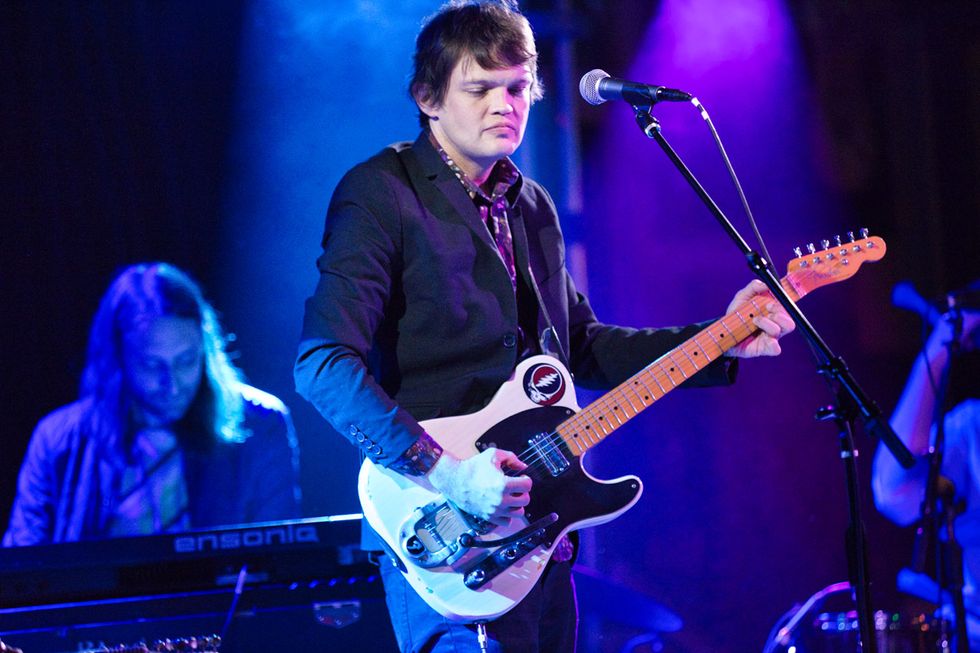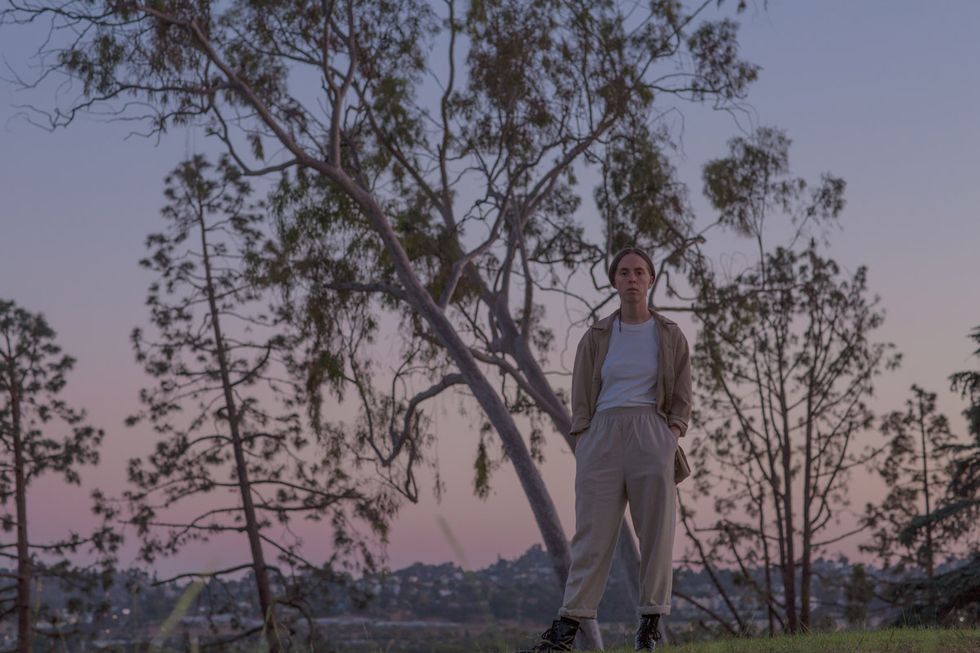On his latest album, Goes West, the fingerstyle guitarist seeks the larger conversation within his instrumental music.
A unique voice amid a new generation of roots-music revivalists, William Tyler shines bright in a musical biome that’s often fixated on the past. Initially emerging as a member of stalwart indie-rock bands Lambchop and the Silver Jews, Tyler has developed into a full-fledged solo artist with a string of critically lauded instrumental-guitar albums that simultaneously honor the genre’s rich history while propelling it forward. As a regular performer at L.A.’s taste-making nightclub Zebulon and the opening act for such diverse artists as Ty Segall, Wilco, Jack White, and indie-pop darlings Real Estate, Tyler has been connecting with audiences eager to hear his progressive take on fingerstyle guitar.
Tyler’s evocative playing has been described as a style of musical portraiture. True to form, his latest release, Goes West, paints a picture of the Western United States through a series of vignettes that are narrated by his fingerpicked acoustic guitar. Unlike the more eclectic and electric guitar-oriented fare of his 2016 release, Modern Country, Goes West is steeped in the tradition of the American Primitive Guitar movement, recalling John Fahey and Leo Kottke’s work. However, Tyler distills the essence of that sound into focused, airtight songs built on pop music’s fundamentals. His remarkably dynamic touch and knack for lyrical phrasing give the songs on Goes West some truly infectious melodic earworms—a rarity in a style of music so often mired in histrionics. While there are occasional bouts of technical flash, Goes West’s songs rarely wander too far from their initial point or linger on any one idea for too long. By fusing American Primitive with pop ideals, Tyler—who is a devoted student of both music history and the guitar—has reimagined a classic sound in a way the social media generation can digest. For those willing to listen closely, there is serious musical depth lurking in Goes West’s apparent simplicity, but it doesn’t insist upon itself.
Tyler’s deft guitar work on Goes West is supported by the equally lyrical drumming of Dawes’ basher Griffin Goldsmith, and his lively acoustic playing finds an ideal dancing partner in the electric guitar textures of session ace and rising star Meg Duffy (Hand Habits, Kevin Morby), who traces Tyler’s beautiful melodies with intriguing textures and counterpoint. The record even boasts a validating cameo performance by one of Tyler’s guitar heroes, jazz innovator Bill Frisell.
Armed solely with a rebuilt 1955 Martin D-18 gifted to him by a beloved late uncle, Tyler wasn’t particularly fussy about the gear on Goes West. Premier Guitar spoke with the guitarist and songwriter as he rested in Nashville before embarking on a tour to promote his new album. Tyler describes the influences that shaped Goes West, his philosophy as an instrumentalist, and why he believes instrumental records need to have a larger message to mean something.
Goes West is a unique take on American Primitive guitar. What sent you down that path this time, as opposed to leaning in on your electric side, as you did on Modern Country?
It was definitely a deliberate choice to lean in on that side of my playing. I think the counterintuitive thing to do after a record like Modern Country was to do an album like this one. A lot of people expected me to make an instrumental rock record that picks up where Modern Country left off. While that’s something I’d still like to do, my writing after Modern Country came out was just more informed by acoustic-centric stuff. I was listening to a lot of classical music and a lot of ambient music, and I was also revisiting the American Primitive stuff and the Windham Hill Records and ECM Records catalogs at the same time.
And I honestly wanted to make a guitar record for guitar nerds. What’s weird is that Goes West has been received by a much broader audience than I expected. Maybe it’s just that people are more aware of what I’m doing now, but it’s getting played on adult alternative radio stations here and there, so it feels like there’s a little more of a mainstream awareness of what I’m doing. I think part of that is that these songs, while indebted to the American Primitive sound, are pretty much all three- or four-minute pop-structured tunes.
You mentioned ECM Records, and one of that label’s original stars, Bill Frisell, made an appearance on Goes West. What was that like for you?
Bill is an all-time hero for me, and I think the aesthetic of that song [“Our Lady of the Desert”] works really well with his style, which is something I aspire to, although our idioms are very different. Frisell’s Nashville record was a really, really big one for me when I discovered it. It showed me that you could make an instrumental guitar record and have it be this thing that’s not just for the heads. Frisell’s one of those guys that’s universally respected for such good reason, and unique in that he’s so well-known from his work with mainstream artists, but also has a background in really deep avant-garde jazz. Frisell’s particular skill set is so rare, and there’s no other figure in modern American music that has that same range. It’s really special to have him on the album.
Did you write the songs on Goes West with specific narratives or themes in mind?
Yeah. There’s not a strict concept for my album necessarily, though it’s obviously Western-themed with its title and what the songs are trying to evoke. I’m very much influenced by history and geography and if I hadn’t gone into music, I think I would have been a teacher. There’s something very concrete about taking inspiration for music from non-musical places.

“I honestly wanted to make a guitar record for guitar nerds,” says Tyler of his latest album. “What’s weird is that Goes West has been received by a much broader audience than I expected.”
The theme concept makes Goes West unique relative to other acoustic instrumental-guitar albums that parrot the American Primitive sound.
I’m definitely more interested in creating a specific mood or story with my records. I don’t want to be precious about it, but I do think there should always be a larger conversation at play that makes it not just another guitar record. It has to have a bigger point.
Walk us through your writing process and how you go about giving your music that bigger point.
I’m pretty aimless about it. I have a wandering mind and that’s how I play, and I just try to carve out time to sit down with the guitar. Sometimes I come to it with some inspiration and sometimes I’m trying to learn a piece of music by another artist and something comes out of that process that’s original. I still look at things as being sort of hook-oriented, like in a pop music kind of way, and if a riff feels like something a song could be built around, I’ll try to follow its path until the piece feels finished in some way.
The songs being more compact on this record is a reflection of the way my process has changed lately—where I really don’t feel the need to chase those wandering, repetitive, themes like the American Primitive composition model. It’s been a conscious intent of mine to shrink the format while still telling the same stories. There’s a lot of melodic movement and different ideas in these songs, but they’re all on the shorter side. They’re sort of vignettes. I think a lot of my songs in general are really like pop songs without words, and I try to give them explicit melodic hooks that the ear can latch onto.
You’re a big fan of the late Michael Hedges. He’s an example of someone who made acoustic guitar albums with really strong songwriting fundamentals, but many people tend to focus on the flashy, percussive side of his playing.
I agree, and he was a really big influence. Hedges’ style of playing was so demonstrative and acrobatic, and I see someone like Tommy Emmanuel really carrying that torch. Hedges was just so percussive and had such a wow factor to his playing, and I think this new generation hasn’t really mined that style very much. The only person I can think of who is indebted to that, and has pushed it further in a way, is Kaki King. She has always been a role model for me—both as a player and a figure.
I’ve played a lot of shows for audiences that definitely have no point of reference for solo guitar music—opening for artists from way outside of what I do—and the stuff that goes over best has to have some flash. There are weird little moments within songs of mine that I know when I play live if I’m going to get a response at all, it’s that moment when it’ll happen. Things like the tapping on “Gone Clear” from Modern Country or the lick from “Fail Safe” on the new one. I think being aware of that thing and embracing it makes what I do more mainstream than a lot of my contemporaries who are more indebted to an older folk idiom or the blues world.
Though Tyler plays his Martin exclusively on Goes West, he has also forged a reputation as an electric guitarist with an original voice. In a recent concert at Nashville’s 3rd & Lindsley music venue, Tyler alternated all evening between his battered flattop and this Bigsby-equipped Tele. Photo by Andy Ellis
Elaborate a bit on the influence you’ve taken from Kaki King.
When I was starting to teach myself stuff in this acoustic instrumental world, she kept coming up. I was trying to figure out who was doing that thing now, that was young and not stuck in this post-Takoma [Records, the late John Fahey’s label] indie underground thing, and I kept coming back to Kaki King and James Blackshaw—I discovered their music at the same time. Kaki’s stuff in particular just didn’t sound like any other guitar music I had ever heard. I think Kaki is an incredible guitar player, but she has a really wide range of reference points. You can tell she’s influenced by the post-rock stuff that was important to a lot of the people in our age group that grew up with indie rock, but also had the Hedges thing and the Windham Hill thing. It all spoke to me deeply. Also, she’s a woman, and the music industry in general—especially the guitar club—is way too much of a dude world, and it’s really boring to me and wrong that there’s not more women represented in it. Thankfully that’s started to change, and I think Kaki was a big part of that shift. A lot of the time, women are the most interesting players. Marisa Anderson is another favorite of mine and Mary Halvorson as well—who comes from the jazz world. Obviously, she’s a giant pop star now, but if St. Vincent wanted to just be a guitar player and do instrumental guitar records, there’s no doubt that she would be at the top of that game because she’s that good. She’s so close to someone like Prince.
What made Meg Duffy the right electric guitarist for these songs?
We jammed a few times when I first moved to L.A. and we had this vibe together as players that was very much like harmony singing. I knew I wanted to revisit that vibe in a longer-form collaboration at some point. Meg reminds me of Bill Frisell in the way she immediately elevates any record that she’s on. She has a way of applying her sound and being true to it, while expanding other people’s visions by being present. They’re both Pisces and that’s not a coincidence!
Did you use many acoustic guitars on the album?
No. I have a 1955 Martin D-18 that’s my main guitar and was the only guitar I played on the record besides a Nashville high-strung Yamaha that belongs to Tucker [Martine, producer/engineer] that I used to double some parts here and there.
The Martin was my uncle’s guitar. He passed away recently, but he gave me that guitar out of nowhere. I had gone to visit him and he used to collect instruments and had all of this random stuff in his attic, and he was like, “Oh yeah, I have this guitar for you.” It was in terrible shape. The neck was coming off and it’s one that was built before Martin started putting truss rods in their guitars, so it required quite a bit of work when I got it back to Nashville. The neck had to be reset twice at a shop called Cotten Music, and the first job got it playable—but the action was really high. They got it right the second time and it had a refret about eight years ago. That guitar has been through a lot since. It has traveled a ton with me, so at this point it feels like a material extension of myself.
You live in open tunings. Which ones did you use on the record?
I use open C major a lot [C–G–C–G–C–E, low to high], which has a major third on top. I believe that’s a Fahey tuning, and I write a lot in that. I also use one that starts as open C major, but you tune the 5th string down from G to F, so you have a fourth in there, and you can also play in F with that tuning. “Fail Safe” is in that tuning. I use one on a couple of tunes on the record that start with that same open C major, but the high E string is tuned up to F. I also use one that’s D–A–D–A–A–E, so you can write in D and A in that tuning in a really interesting way.
Led Zeppelin was probably the window into open tunings for me before anything, though. Led Zeppelin III and Physical Graffiti and all of their mid-period stuff was very influential to me, and I feel like I owe as much to Jimmy Page as I do to John Fahey. I have a problem with the aesthetic they embodied in a lot of ways, and I acknowledge that they pilfered a lot of their stuff, but as a player, Jimmy Page was a window for so many people into more obscure music and folk music. I found out about Fairport Convention through Led Zeppelin, and that was a huge thing for a lot of people, even back then.
With all of the open tunings, do you change string gauge often?
No, I use light gauge and sometimes tuning the B string down in a light gauge is a little tricky, but I don’t want to start using hybrid sets. When I tune the G back up to A, it really helps to have lighter gauge strings for stability.
Your fingerstyle technique is really advanced. How did you go about making the transition as someone that came up as a pick player?
I still consider myself a pick player, to a degree. I started out with Travis-style picking and then started learning different patterns. I wasn’t exactly trained in any particular way, but I put in the most work learning different triplet patterns and different thumb patterns. It’s still a developing thing—I’m just now starting to incorporate the ring and the pinky finger on my right hand.
In my experience, the best vintage Martins are those that have been through a lot and been pieced back together a few times.
Oh, totally! There’s something about those guitars that the more lived-in they are, the better they get. It’s like how designer denim or good cowboy boots become this thing now where you buy a pair and wear it for life and it’s supposed to mold to your body in this quasi-parasitical, hive-mind way, and those guitars are part of that and become a part of you.
You grew up in Nashville with some seriously heavy-hitting professional songwriters for parents. How did that upbringing shape your songcraft?
My dad, Dan Tyler, started working with Eddie Rabbitt in the ’70s, and my mom Adele is a songwriter also. [Editor’s note: Adele and Dan Tyler penned hits individually and together for such artists as LeAnn Rimes and the Oak Ridge Boys.] Growing up in Nashville, there’s an innate respect for approaching music in a very craftsman-like way. There are wildly talented people where I live in L.A., but there’s a thing where people there talk a lot about what they’re doing and their process, and Nashville has a thing where people just do stuff without the conversation or fanfare. As much as celebrity culture is a part of Nashville, there’s this side of the music business there with people like my parents who stay behind the scenes and make it happen—songwriters, session players, producers—and they’re often kind of anonymous. I think of Reggie Young, who just passed away, and he’s one of my guitar heroes and he played on songs like “Son of a Preacher Man” and “Suspicious Minds”—some of the most memorable songs of all time—and he could walk into any coffee house in Nashville and people wouldn’t have known who he was.
There’s an aspect of Nashville that’s very humbling, and that is that no matter how good you are, there’s always someone better than you there. They might be 20 years old or they might be 80, and these guys all play together and things like age don’t separate people there—it’s about your skill. Even the major country stars like Vince Gill and Keith Urban are way, way better guitarists than many who do it full time. Keith Urban is as good a player as someone like Slash—but guitar is like the third thing on his agenda as a musician.
The thing that Nashville and my parents’ work instilled in me is a sense of being humble. In the indie and alt-rock underground world, there’s all of this self-importance. I think people in that world love to lean on words like virtuoso because we’re all wildly insecure since our music isn’t necessarily all that commercial. It doesn’t mean such music isn’t just as valid as anything else, but most of us aren’t virtuosos. If you’re confident about your voice, you’re good. It’s like being a singer: You look at someone like Sinatra who isn’t about technicality—his timbre and timing and personality supersedes pitch and range and such. I try to look at guitar playing like that.
William Tyler performs “Call Me When I’m Breathing Again”—a track from Goes West—with electric guitar accompaniment by Hand Habits’ Meg Duffy.
Photo by Aubrey Trinnamen
Meg Duffy: Listening for Emotional Content
Better known these days as the sole member of breakout indie-rock project Hand Habits, Meg Duffy is also the guitarist indie-rockers and singer/songwriters have called upon for years when they need texture, movement, and lead guitar accompaniment that’s spellbinding. Duffy has worked with the War on Drugs, Kevin Morby, and Weyes Blood, and is now the electric guitarist on William Tyler’s Goes West. We spoke with Duffy—the guitarist identifies as non-binary and uses they/them pronouns—about how they approach forging guitar parts that take a track to the next level.Your playing works both against and with William’s guitar without walking over it. Do you have a specific approach to adding that kind of subtle color and texture?
In this case, it was important to remember that it was William’s record and his guitar and his melodies are really the voice of the record. As a session player, you’re either brought in as a soloist or as a secondary voice to add to a composition, so it’s really important to know it’s not about you—it’s about playing a supporting role musically.
What was the process like on your end?
William gave me complete creative control and trust over the parts I was playing, and since the core arrangements were already there, I pretty much arranged my stuff on the fly. We would do a few takes of each song and pick a favorite. As someone who’s brought in and not a member of the band, it can be a bad idea to create a part before you go into the studio because then your brain gets attached to that part. It can be really difficult to hear that song or part in a different way if what you conceived doesn’t work for everyone. So I didn’t want to pre-compose any parts without William there, for fear that it wouldn’t be the right vibe.
You’ve done a lot of work recently creating your own music as a guitarist and vocalist as Hand Habits. Was it liberating to work on a strictly instrumental release and lean back into your guitarwork?
For sure in some ways, but in other ways it’s a lot harder. People are listening to the instruments more closely with a record like this. In sessions I’ve done with vocalists, the musicians are listening to the full instrumentation, but the average listener isn’t paying such close attention to the chords being played or the tones. Because there’s so much stripped away here, I felt more pressure to bring my best self musically. It was less about just serving the vibe of the song and more about “how does this work harmonically and melodically with what’s being played?” And it’s even more challenging because William is such an incredible player himself and these arrangements are so beautiful. I had to ask myself how I could blend and add to songs that already stood up so well on their own.
What advice can you offer for crafting electric guitar tones that work as counterpoint to acoustic guitars without sticking out?
Really listen to what the composer is saying and what the emotional content is. A lot of people don’t really play emotionally, they play narcissistically. If you’re a musician, you’re probably at least a little bit of a narcissist—and that’s okay—but you need to remember that it’s not about you sounding cool or you sounding good as a player, it’s about the song. So a lot of the tonal choices we made were really simple, like adding some brightness or something with some space to it because the acoustic guitar has so many frequencies covered already.




